The Passo Giau is one of several high passes in the Dolomites. I have visited it a few times and in my view this is the most attractive pass in this part of the Italian Alps. Hence this report.
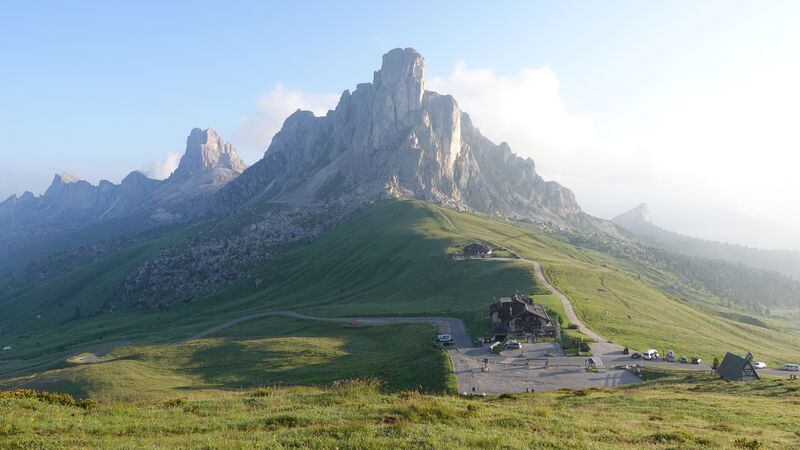
The Passo Giau is a mountain pass on the road Strada Provinciale 638 (SP638) that connects Selva di Cadore and Cortina d’Ampezzo in the Dolomites, Italy. The south access from Selva di Cadore is a bit shorter, around 10 km or so.
The Pass offers a plethora of activities catering to diverse interests.
- For hiking enthusiasts, there are numerous trails that wind their way through the surrounding mountains, offering varying levels of difficulty.
- Motorcycling enthusiasts are drawn to the winding roads of Passo Giau, offering an exhilarating ride through the mountains. The serpentine roads provide not only a thrilling experience for riders but also picturesque views at every turn.
- Cyclists can challenge themselves on the steep ascents and enjoy the rewarding descents, all while immersing themselves in the awe-inspiring scenery.
- Photographers find Passo Giau to be a paradise for capturing stunning landscapes. The changing light throughout the day, coupled with the dramatic mountainous backdrop, provides endless opportunities for capturing mesmerizing photographs.
I myself have been in the area a few times and visited the Pass as well as some other attractions in its vicinity. More about the pass and activities when you get there you can read in the text below.
Passo Giau Map
The road and the pass are shown in the interactive map below, so zoom out to see wider area with roads that converge to Cortina d’Ampezzo on the east side and Selva di Cadore in the south. Zoom in for more details:
Giau Pass – Bassic Data
The pass is also known as Jof de Giau and Suogo de Jou. It is perched at an elevation of 2236 meters (7336 feet) above sea level, so it is among the highest in the Dolomites. It is higher than Passo Sella and the nearby Falzarego Pass. Note that Passo Pordoi is only a few meters higher.
It serves as a gateway to the Dolomite Mountains, a UNESCO World Heritage Site, making it a must-visit destination for travelers seeking an authentic and immersive experience in the lap of nature.
The road was completed and fully paved in 1986. Known for its harsh and relentless gradients, it is one of the most visited Dolomite passes. It is passable by trucks and coaches. But you have 55 sharp hairpin turns up to the top and 13% of maximum gradient at some places.
The road is open year round. You might want to know that this place is also on the Alta Via 1 route.
Passo Giau is situated in the Veneto region, within the province of Belluno, Italy. Its precise location in the heart of the Dolomite Mountains offers awe-inspiring views and a tranquil ambiance.
Surrounded by towering peaks and lush valleys, Passo Giau provides a gateway to the wonders of nature, making it a prime destination for outdoor enthusiasts. This is a place of unparalleled natural beauty, captivating visitors with its breathtaking views and enchanting atmosphere.
- Useful map: Cortina d’Ampezzo e Dolomiti Ampezane, 1:25000, Tabacco, 03.
Attractions around Giau Pass
There is a small hotel at the pass, the official name is Berghaus Hotel Giau Pass. There is plenty of free parking space around, see how it looks:
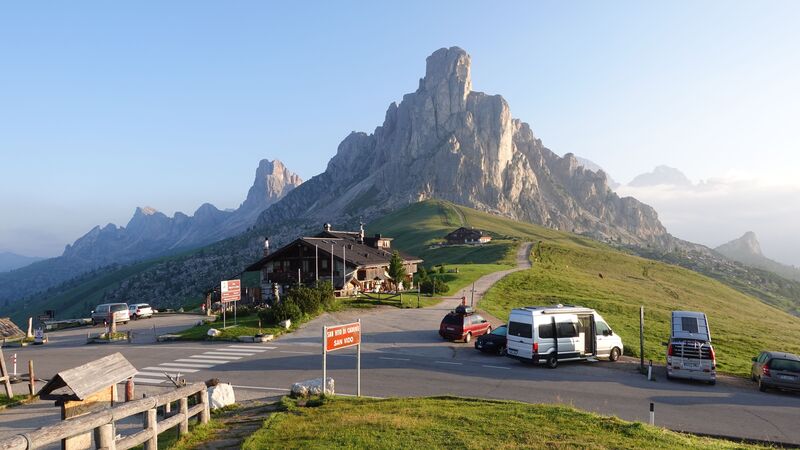
I was there in the morning and the hotel was closed, see the picture, so I could not make some pictures from inside. As you realize, the bar opens surprisingly late.
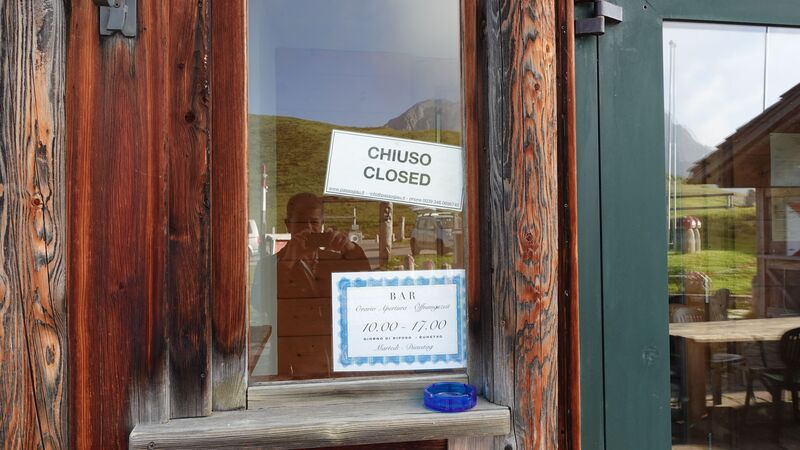
There is also a church below the pass on the Selva di Cadore side, known as Chiesa di San Giovanni Gualberto.
The impressive peak that you see in the background of some of the pictures on the north side of the pass is Monte Ragusela (Ra Gusela, 2595 m) above the sea level. Behind it you have peaks of Nuvolau (2574 m) and Averau (2647 m).
The map below shows some details, so note that you have a ferrata route which you can use to get to Rifugio Nuvolau from the east side.
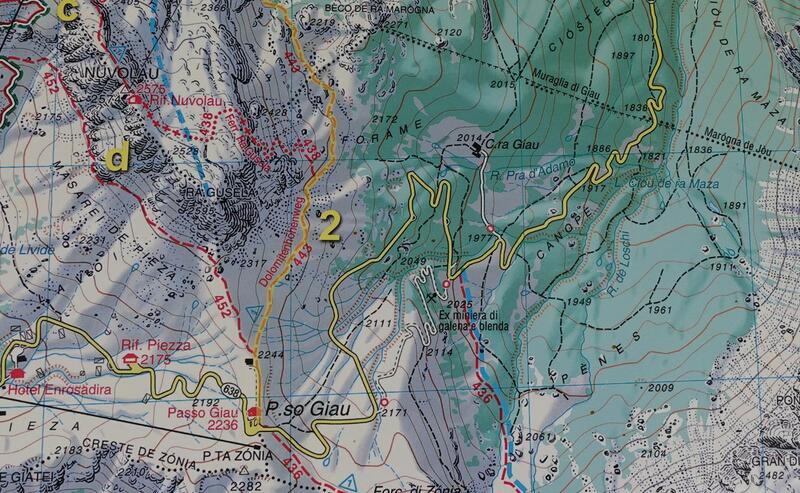
There is also a normal walking route on the west side of this mountain group, so you can easily get to Rifugio Averau as well. You can explore details in the interactive map given previously in the text above.
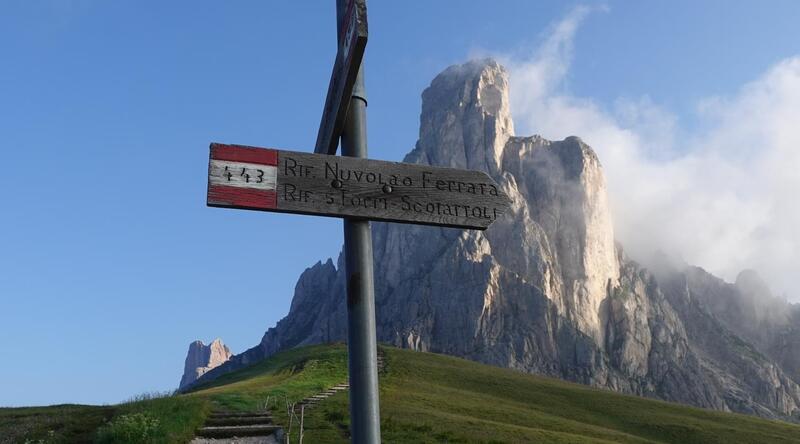
A few kilometers down the road in the direction of Cortina, you have a parking from where routes starts to Cinque Torri and also to Lago Federa, both major attractions of the Dolomites. But note that you have the route 443 to Cinque Torri also at the Pass, see the picture:

What sets Passo Giau apart is its untouched natural beauty and serene ambiance. Unlike some of the more crowded tourist spots, Passo Giau provides a tranquil retreat for those looking to escape the hustle and bustle of city life.
The air is crisp, the silence is profound, and the scenery is nothing short of spectacular. The pass is blanketed with wildflowers during the spring and summer, transforming the landscape into a vibrant mosaic of colors.
In autumn, the foliage takes on rich hues of red and gold, creating a captivating contrast against the rugged mountains.

Spectacular drone landscapes are available in this video:
Hiking around Passo Giau
The map below from AllTrails shows a route which you can follow to see some attractions in the area. The route is 10 km total length.
If you follow the previous link to AllTrails, you will be able to find more of such maps for this particular or any other area. But read also my full report about a round tour in the area.
Conquering Passo Giau: Beginners Guide to Cycling the Route
Cycling enthusiasts seeking a thrilling yet rewarding challenge will find Passo Giau, nestled in the heart of the Dolomite Mountains, to be an exhilarating destination.
This beginners’ guide is your key to conquering the Passo Giau cycling route, offering valuable insights, safety tips, and recommendations to make your cycling adventure a memorable experience.
Introduction to Cycling in Passo Giau
Passo Giau is a cyclist’s paradise, offering a perfect blend of scenic beauty and challenging terrain. This legendary mountain pass is a magnet for riders, drawing them with its serpentine roads, steep ascents, and breathtaking vistas.
Cycling in Passo Giau provides a unique opportunity to test your endurance while immersing yourself in the natural splendor of the Dolomite Mountains.
In this video you can see how to get to the pass by a bicycle from Cortina d’Ampezzo side:
The Best Seasons and Times for Cycling
The ideal seasons for cycling in Passo Giau are spring, summer, and early autumn. During these months, the weather is relatively stable, and the roads are clear of snow and ice, ensuring a safer cycling experience.
Spring (May to June) and early autumn (September to October) offer milder temperatures and fewer crowds, allowing cyclists to enjoy the route with more tranquility.
In terms of timing, early mornings or late afternoons are recommended. The cooler temperatures and softer lighting not only enhance the overall experience but also contribute to a more comfortable ride. Avoid cycling during peak sunlight hours, especially in summer, to prevent overheating and fatigue.
So conquering Passo Giau on a bicycle is a rewarding endeavor that promises a sense of accomplishment and a deeper connection with nature.
By understanding the route, being mindful of safety, and choosing the right season and time for your adventure, you can make the most of this exhilarating cycling experience. So gear up, pedal your way to the summit, and savor the breathtaking views that await you at Passo Giau.
A Closer Look at the Distinct Flora and Fauna
Passo Giau in the magnificent Dolomite Mountains of Italy, isn’t just a haven for outdoor enthusiasts; it’s also home to a rich tapestry of unique flora and fauna. Let’s take a closer look at the biodiversity that makes Passo Giau a natural treasure and the significance of preserving and respecting the environment.
Unique Biodiversity of Passo Giau
Giau Pass boasts a remarkable diversity of plant and animal life. The high-altitude environment, with its mix of alpine meadows, rugged rock formations, and dense forests, creates a habitat that’s quite distinct from the surrounding lowlands.
Key Species to Look Out For
Flora:
- Edelweiss (Leontopodium nivale): The iconic and rare Edelweiss, with its distinctive woolly white petals, can be found in the rocky crevices and alpine meadows of Giau Pass. This alpine flower is a symbol of purity and is a must-see for nature enthusiasts.
- Mountain Avens (Dryas octopetala): With its star-like white flowers and vibrant green leaves, the Mountain Avens thrives in the harsh alpine conditions of Passo Giau.
- Gentian (Gentiana): Passo Giau is also home to various species of Gentian, with their striking blue and violet blooms adding splashes of color to the landscape.
Fauna:
- Chamois (Rupicapra rupicapra): These agile, goat-like animals are a common sight in the region, gracefully leaping across steep rocky terrain. They are well-adapted to the challenging environment of Passo Giau.
- Golden Eagles (Aquila chrysaetos): These majestic raptors soar through the skies, their keen eyes hunting for prey among the mountainous landscapes. Witnessing their impressive aerial displays is a sight to behold.
- Marmots (Marmota): These charming, burrowing rodents are often seen sunbathing near their burrows in the summer months. Their distinctive whistle-like calls echo through the valleys.
The Importance of Conservation and Respecting Nature
The fragile ecosystem of Passo Giau, like many alpine environments, is susceptible to the effects of climate change and human activity. It is imperative that visitors and nature enthusiasts act as responsible stewards of this natural wonder.
Conservation efforts, both local and national, play a crucial role in preserving the unique biodiversity of Passo Giau. Protecting these ecosystems not only maintains their aesthetic beauty but also sustains the balance of nature.
This entails following established rules and regulations, such as staying on marked trails, not disturbing wildlife, and adhering to Leave No Trace principles.
As visitors, our enjoyment of Passo Giau comes with the responsibility of treading lightly on this delicate environment. By respecting the flora and fauna and advocating for their protection, we ensure that Passo Giau remains a thriving natural gem for generations to come.
Through education and awareness, we can continue to marvel at the distinctive biodiversity that makes Passo Giau a place of wonder and reverence.
Unlocking Local Culture: Understanding Passo Giau’s History and Traditions
Nestled within the embrace of the Dolomite Mountains, Passo Giau not only offers breathtaking natural beauty but also holds within its folds a rich tapestry of history and traditions.
Exploring the local culture of Passo Giau provides visitors with a unique opportunity to connect with the region on a deeper level, understanding the roots that make this mountainous haven truly special.
Rich History and Culture of Passo Giau
Passo Giau’s history is intertwined with the ancient tales of shepherds and mountaineers who called these rugged landscapes home. Over the centuries, Passo Giau has been a crossroads for travelers and traders, leaving behind a legacy of diverse influences.
The local architecture, with its rustic charm, stands as a testament to the region’s historical heritage, reflecting a blend of Alpine and Venetian styles.
Local Festivals and Traditions: Celebrating Life in Passo Giau
Passo Giau comes alive with vibrant festivals and traditions that reflect the spirit of its inhabitants. One such celebration is the traditional Alpine festival, where locals and visitors gather to revel in music, dance, and local cuisine.
The festival showcases the region’s folk traditions, featuring colorful costumes, lively folk dances, and traditional music that echo through the valleys, creating an atmosphere of joy and camaraderie.
Another cherished tradition is the annual cattle drive, where herds of cattle are guided down from the high mountain pastures to the valleys as winter approaches. This ancient practice not only marks the change of seasons but also serves as a communal effort, bringing together villagers in a display of unity and shared heritage.
Local Culture Influencing Life at Passo Giau
The influence of local culture is palpable in everyday life at Passo Giau. From the hearty Alpine cuisine served in local restaurants, featuring delectable dishes made from locally sourced ingredients, to the warm hospitality extended by the residents, visitors can experience the genuine essence of the region.
Traditional craftsmanship, including woodwork and embroidery, continues to thrive, showcasing the skills passed down through generations.
Moreover, the respect for nature and the deep connection to the land are integral parts of the local ethos. Sustainability practices and eco-conscious initiatives are embraced, preserving the natural beauty of Passo Giau for future generations to enjoy.
Capturing Passo Giau: A Photography Guide
Passo Giau, with its dramatic mountain vistas and enchanting landscapes, offers a photographer’s dream canvas. To truly capture the essence of this breathtaking locale, mastering the art of photography amidst its natural wonders is essential.
Tips for Capturing the Breathtaking Beauty of Passo Giau
- Golden Hours Magic: Make the most of the golden hours—sunrise and sunset. The soft, warm light during these periods adds a magical touch to your photographs, casting a golden glow on the mountains, meadows, and valleys, enhancing their beauty manifold.
- Embrace the Seasons: Passo Giau undergoes remarkable transformations with each season. In spring, the vibrant wildflowers carpet the meadows, while autumn paints the foliage in rich hues of red and gold. Visit during different seasons to capture the diverse moods and colors of the landscape.
- Composition is Key: Pay attention to composition. Frame your shots with interesting foreground elements, such as wildflowers, rocks, or winding paths, to add depth and perspective. Experiment with different angles and viewpoints to find the most captivating composition for your photographs.

Best Spots for Photography
- Monte Nuvolau: Offering panoramic views of the surrounding peaks, Monte Nuvolau (2574 m) is a prime spot for capturing the vastness of the Dolomite Mountains. The sunrise and sunset views from here are particularly mesmerizing.
- Alpine Meadows: The lush alpine meadows dotted with colorful wildflowers provide a picturesque setting. These meadows, especially in spring and early summer, offer excellent opportunities for capturing the region’s natural beauty up close.
- Mountain Pass Roads: The winding roads of Passo Giau provide dynamic leading lines and sweeping vistas. Capture the serpentine roads as they disappear into the mountains, creating a sense of adventure and mystery.
The Importance of Light, Time, and Angle in Photography
- Play with Light: Understand how light interacts with the landscape. Experiment with different lighting conditions, shadows, and reflections. Side-lighting can emphasize textures, while backlighting can create a halo effect around your subjects.
- Timing is Everything: Timing your shots is crucial. Patience is key, especially when waiting for the perfect moment during sunrise or sunset. The changing light and colors can transform an ordinary scene into a masterpiece.
- Consider Angles: Vary your shooting angles. Capture the landscape from different heights and perspectives. Low angles can add drama to your shots, while high angles provide a broader view of the surroundings.
So capturing the essence of Passo Giau through photography is a blend of technical skill, artistic vision, and an appreciation for the natural beauty that surrounds you.
By embracing the tips provided and immersing yourself in the landscape, you can create stunning photographs that not only showcase the allure of Passo Giau but also evoke a sense of wonder and admiration for this captivating destination.
Booking Your Stay
Note that this is about the Dolomites, and this is the most popular area in the Italian Alps. It is very crowded in particular in summer. So it is advisable to book your accommodation well in advance. This holds for any type of accommodation in the area.
My best experience so far has been with Booking company. Most of the time I rent small flats that are fully equipped, with kitchen and everything you need to feel comfortable.
Summary
In conclusion, Passo Giau stands as a captivating destination in the heart of the Dolomite Mountains, offering a wealth of natural beauty, outdoor activities, and cultural experiences. Its untouched landscapes, diverse flora and fauna, and rich local traditions make it a haven for nature enthusiasts, photographers, cyclists, and travelers seeking a tranquil retreat.
Whether exploring the winding roads, hiking the scenic trails, or capturing the breathtaking views through a lens, Passo Giau invites visitors to immerse themselves in its unique charm.
In terms of mountaineering, I do not think it is as attractive as Pass Pordoi where you have Piz Boe with all that it has to offer. But for cyclists and motorbike riders, this is one of the best places in the Alps.
If you are just passing through the Dolomites and have to time to stay, here is a car drive over the pass from the Cortina side, have a look:
Bookmark this site and keep as a reference, you will always find new texts of this type published here. Thank you for reading.
Passo Giau FAQs
1. What is Passo Giau?
Passo Giau is a mountain pass situated in the Dolomites of northern Italy. It is renowned for its scenic beauty, offering breathtaking views of the surrounding peaks and valleys.
2. Where is Passo Giau located?
Passo Giau is located in the province of Belluno, Veneto, in the Italian Alps. It is part of the Dolomite mountain range and is often visited by nature enthusiasts, hikers, and cyclists.
3. How do I reach Passo Giau?
Passo Giau is accessible by car, and the nearest towns include Cortina d’Ampezzo and Colle Santa Lucia. The pass is well-connected by roads, and driving is a common way to reach this picturesque location.
4. What activities can I do at Passo Giau?
Passo Giau is popular for outdoor activities such as hiking and cycling. The area offers various trails with different difficulty levels, providing opportunities for both casual and experienced outdoor enthusiasts.
5. Are there accommodations near Passo Giau?
Yes, there are accommodations available in nearby towns and villages like Cortina d’Ampezzo, offering a range of hotels, guesthouses, and chalets for visitors.
6. Can I visit Passo Giau in the winter?
Yes, Passo Giau is accessible in the winter, and it becomes a hub for winter sports enthusiasts. The area is known for its cross-country skiing and snowshoeing opportunities, and the snow-covered landscape adds to the charm.
7. Are there any restaurants or cafes at Passo Giau?
While there may not be many facilities directly at the pass, there are restaurants and cafes in nearby towns where visitors can enjoy local cuisine and beverages.
8. Is Passo Giau part of any hiking trails or long-distance routes?
Yes, Passo Giau is often included in various hiking trails and long-distance routes, including the Alta Via 1, a renowned trekking route in the Dolomites.
9. Can I drive through Passo Giau?
Yes, Passo Giau is accessible by car, and the scenic drive offers panoramic views of the Dolomite mountains. It is a popular route for motorists and motorcyclists.
10. What is the best time to visit Passo Giau?
The best time to visit Passo Giau depends on personal preferences. Summer is ideal for hiking and enjoying the lush landscapes, while winter attracts those interested in snow sports and the serene winter ambiance. Fall also offers beautiful foliage in the surrounding forests.
Leave a Reply